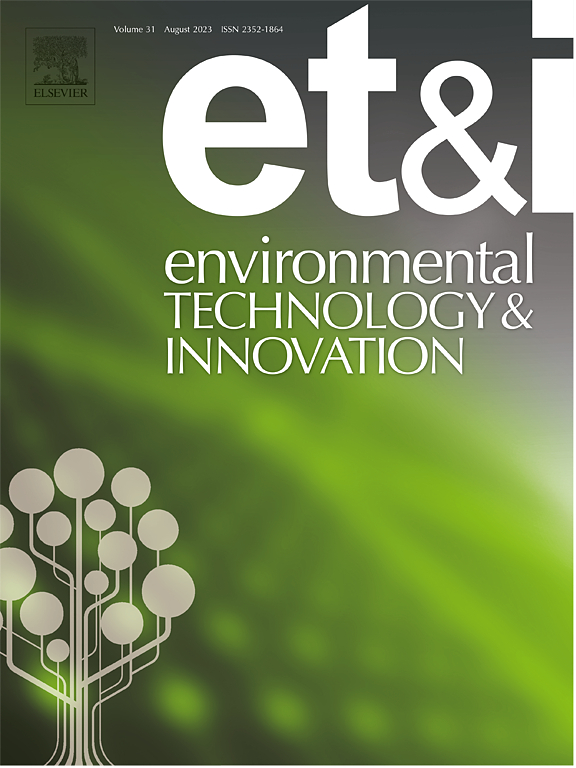Enhanced cadmium sequestration from animal waste using a combined modified corn straw biochar: Unraveling the mechanisms and performance in hazardous metal removal
IF 6.7
2区 环境科学与生态学
Q1 BIOTECHNOLOGY & APPLIED MICROBIOLOGY
引用次数: 0
Abstract
Cadmium (Cd) is a toxic metallic element, and Cd residues in livestock and poultry manure pose a significant risk to agri-environmental sustainability, food safety and human health as it is returned to the field. This study focuses on the remediation of Cd in livestock manure through the development of a novel modified corn straw biochar (MCSB) using magnesium ions (Mg2+), sodium sulfamate (SS), and nano zero-valent iron (nZVI).Comprehensive characterization by scanning electron microscopy (SEM), Fourier transform infrared spectrometry (FTIR), Brunauer-Emmett-Teller (BET), and X-ray diffraction (XRD) reveals that MCSB exhibits enhanced hydrophilicity, with a 260 % increase in specific surface area compared to the unmodified biochar. It contains rich oxygen-containing functional groups and has a rough surface with numerous irregular particles and crystalline substances, providing abundant active sites for Cd adsorption. Adsorption experiments showed that the adsorption process of Cd by MCSB was spontaneous monolayer adsorption. Composting experiments indicate that MCSB effectively promotes the transformation of Cd from bioavailable forms to potentially available and residual states, with conversion efficiencies ranging from 36.98 % to 41.61 %. The passivation mechanism mainly involves electrostatic adsorption and reactions of functional groups. Oxygen-containing groups reduce the bioavailability of Cd, the increased pH enhances the negative charge of MCSB for Cd attraction, and water-soluble Cd is adsorbed and precipitated through interactions with surface functional groups.
复合改性玉米秸秆生物炭增强动物粪便中镉的固存:阐明去除有害金属的机制和性能
镉(Cd)是一种有毒的金属元素,畜禽粪便中的Cd残留物在返回田间时对农业环境可持续性、食品安全和人类健康构成重大风险。研究了利用镁离子(Mg2+)、氨基磺酸钠(SS)和纳米零价铁(nZVI)制备玉米秸秆生物炭(MCSB)对畜禽粪便中镉的修复作用。通过扫描电镜(SEM)、傅里叶变换红外光谱(FTIR)、brunauer - emmet - teller (BET)和x射线衍射(XRD)等综合表征表明,MCSB具有增强的亲水性,比表面积比未改性的生物炭增加260 %。它含有丰富的含氧官能团,表面粗糙,有大量不规则颗粒和结晶物质,为Cd吸附提供了丰富的活性位点。吸附实验表明,MCSB对Cd的吸附过程为自发单层吸附。堆肥实验表明,MCSB能有效促进Cd从生物有效态向潜在有效态和残留态转化,转化效率为36.98 % ~ 41.61 %。钝化机理主要包括静电吸附和官能团的反应。含氧基团降低了Cd的生物利用度,pH升高使MCSB的负电荷增强,从而吸引Cd,水溶性Cd通过与表面官能团的相互作用被吸附和沉淀。
本文章由计算机程序翻译,如有差异,请以英文原文为准。
求助全文
约1分钟内获得全文
求助全文
来源期刊

Environmental Technology & Innovation
Environmental Science-General Environmental Science
CiteScore
14.00
自引率
4.20%
发文量
435
审稿时长
74 days
期刊介绍:
Environmental Technology & Innovation adopts a challenge-oriented approach to solutions by integrating natural sciences to promote a sustainable future. The journal aims to foster the creation and development of innovative products, technologies, and ideas that enhance the environment, with impacts across soil, air, water, and food in rural and urban areas.
As a platform for disseminating scientific evidence for environmental protection and sustainable development, the journal emphasizes fundamental science, methodologies, tools, techniques, and policy considerations. It emphasizes the importance of science and technology in environmental benefits, including smarter, cleaner technologies for environmental protection, more efficient resource processing methods, and the evidence supporting their effectiveness.
 求助内容:
求助内容: 应助结果提醒方式:
应助结果提醒方式:


